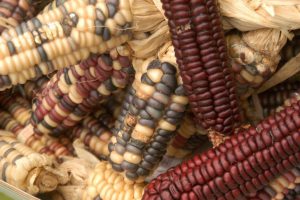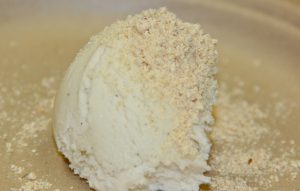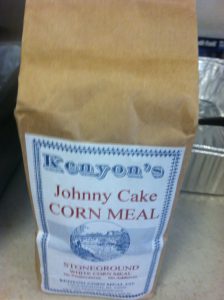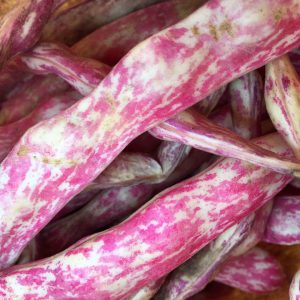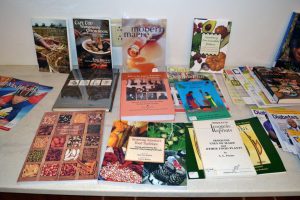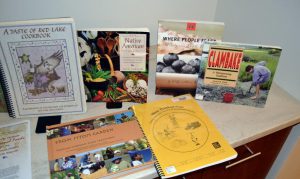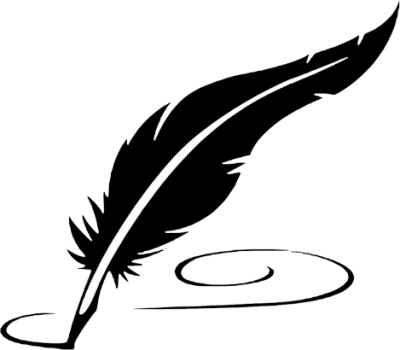Wikôtamuwôk Wuci Ki tà Kihtahan (A Celebration of Land and Sea):
Modern Indigenous Cuisine in New England
Preface
As a Mohegan tribal member, I grew up attending festivals and events that centered around indigenous food, such as the Green Corn Festival, Succotash Time, and summer powwows throughout New England. Many of our traditional stories also relate to food. Tales of Moshup the giant and his wife, Granny Squannit, the leader of the Little People, emphasize land and sea. This is important because many tribes in New England live along the shoreline, and therefore have the ability to hunt and fish. Granny is known as the keeper of the plants and medicine while Moshup tales relate to the ocean. Moshup would wade out into the water and kill whales, which he would share with his people.
In my Mohegan community as well as throughout New England, many Algonquian peoples continue to keep these traditions alive. Today at Mohegan we honor Granny Squannit through an herb garden at our tribe’s Tantaquidgeon Museum. We also have an educational garden where we teach children how to plant traditional crops such as corn, beans, squash, and Jerusalem artichokes. In years past, our tribal elders had a “Three Sisters Garden” at our elderly housing. In this paper, I seek to honor those ancient connections to land and sea by demonstrating the continuity of indigenous cuisine in New England.
Introduction
New England Natives (i) are often overlooked due to their long history of colonization and assimilation, and therefore, the myth of the “vanishing Indian” is most prominent there. Many Americans only learn about the “first Thanksgiving,” and then Natives in New England disappear from history. However, the Native people of New England never truly “vanished,” and many cultures have flourished throughout the region’s complex history.
Contemporary American food culture has similarly elided its indebtedness to the indigenous people of New England. Traditionally, food there was hunted, planted, caught, and harvested seasonally. Stories and celebrations about food went along with those seasons, and were a way of bringing communities together. Although due to colonization much has changed, many of these same types of celebrations still occur, such as the Green Corn Festival at Mohegan.
Today, Native chefs in New England utilize indigenous ingredients such as clams, deer, corn, and strawberries to create both traditional and modern dishes, which are celebrated at events such as the Strawberry Thanksgiving Festival at the Tomaquag Museum and the Mohegan Wigwam Festival. Some Native chefs are much sought after for their johnny cakes (or journey cakes), as well as other indigenous foods.
Dale Carson, Abenaki caterer, cookbook author, and Food Columnist for Indian Country Today, writes, “The ways of the Native ancestors are well documented, including their economy and ingenuity in farming and cooking… the documentation is written primarily in the past tense, and scarcely suggests the living traditions” (p. xi). This study focuses on contemporary Algonquian cooks living in New England and their approach to Native cuisine. (ii) Through interviews with Mashpee Wampanoag, Abenaki, Mohegan, and Narragansett cookbook writers, food journalists, powwow chefs, home cooks, and restaurant owners, I will demonstrate how the Native people of New England have continued to use the same ingredients that were available at the time of the much misunderstood “First Thanksgiving” to create their own modern indigenous cuisine.
History of Indigenous Cuisine in North America
The locavore movement is a current trend throughout the United States, but many people forget that Native Americans have always been eating this way. According to Dale Carson, about 75% of the world’s foodstuffs are indigenous to the New World, including corn, potatoes, tomatoes, and beans. “For millennia, Native peoples of North and South America have cultivated a vast variety of crops, gathered wild nuts and berries, and enjoyed an abundance of fish, fowl and game meats” (p. xi). Prior to contact with the Europeans, about 1000 varieties of plants were utilized as food” (#?).
Native people throughout the country relied on food that was planted, caught, hunted, or found in the wild. Fish and game made up the bulk of the protein, and shellfish was very abundant in coastal regions. In order to add flavor, seeds, nuts and roots were added. Natural sweeteners were used, made from berries, fruits, corn, and maple syrup (Cox & Jacobs). In 1770, English missionary J. Heckewelder noted, “they make use of various roots of plants, fruits, nuts, and berries out of the woods, by way of relish or as a seasoning to their victuals, sometimes also from necessity” (p. 193). Salt and peppers were used to add flavor as well (Raine).
Meats and vegetables were roasted over a fire, boiled, or cooked in pits filled with burning coals. Heckewelder observed, “Their roasting is done by running a wooden spoon through the meat, sharpened at each end, which they placed near the fire, and occasionally turn. They broil on clean coals, drawn off from the fire for that purpose” (p. 196).
In the morning, a big meal would be presented in a single pot. There was usually some type of bread which could would be dipped into the pot and utilized in place of a spoon. In New England and other coastal regions, seashells were also used as spoons and serving dishes (Dale Carson, Personal Communication, May 25, 2013). Although there was only one meal prepared, food was constantly available. Stews would be cooking throughout the day, and no one would go hungry (Raine). Upon the arrival of the colonists, things changed a great deal. In the 1789 Mohegan Petition “To the Most Honourable Assembly of the State of Connecticut,” Mohegan Deacon Henry Quaquaquid stated,
The Times are exceedingly alter’d, Yea the Times have turn’d everything up Side Down, or rather we have Chang’d the Good Times, Chiefly by the help of the White People; For in Times past, our Fore Fathers lived in Peace, Love and great harmony; and had every thing in Great plenty . . . And they had no Contention about their Lands. It lay in Common to them all, and they had but one large Dish, and they Cou’d all eat together in Peace and Love . . . (CT Indian Papers).
This quote demonstrates the attitude that surrounded food for indigenous people. It was communal and meant to be shared.
Storage
In the summer and fall, when many vegetables and plants were at their ripest, people would gather them in abundance (Cox & Jacobs). Berries could be eaten fresh or dried, and sometimes blended into a paste of dried meat and lard called Pemmican, “a Cree word meaning fat” (Carson, p.156). (iii) Pemmican is a traveling food, commonly eaten in New England and other regions. It consists of “some kind of corn meal mixture, which is needed to bind the dried meat or dried fish, dried fruit of any sort together with a little fat. You can grab it with your hand until it sticks together and eat it while you’re running” (D. Carson, Personal Communication, May 25, 2013). (iv)
Food and Ceremony
In ceremony, feasting is an eternal component. In New England and throughout the country, indigenous people still feast after a pipe ceremony or sweat lodge. (v) “[M]ost Native peoples gather and cook foods in a uniform spirit of respect for Nature and for the gifts of the Creator” (Carson, p. xi). Likewise, in the Southwest, when people gathered, corn, beans, and squash, ceremonies were important to guarantee the availability of the harvest. Corn dances are still occurring in the Southwest today (Cox & Jacobs).
Introduction of Materials by Europeans
The Europeans settlers introduced many new tools and products, which indigenous people throughout the country, incorporated into their cooking methods, such as “brass and copper kettles for cooking, guns and metal traps for hunting” (Cox and Jacobs, p. 14).
These new tools aided the Native peoples in hunting, cooking, and serving food. However, the diseases which the settlers brought with them from Europe killed massive groups of people and also disturbed their “hunting territories or took over fallow Indian planting grounds” (Cox and Jacobs, p. 14). Many Native people throughout the country were forced into signing treaties and giving up much of their land, and some tribes were pushed out of their homelands and given other land, such as the Choctaw, who were moved from Mississippi to Oklahoma (Cox and Jacobs).
According to Mohegan Tribal Historian Melissa Tantaquidgeon Zobel, in New England, some tribes, such as the Mohegan and Narragansett, were lucky in that they were able to remain in their homeland due to being Christianized and civilized very early on (Fawcett, 1995). Therefore, many of the ingredients that we as Native people in New England utilize in our indigenous cuisine are the same ones that our ancestors have been using for thousands of years.
Today, modern indigenous cookbooks demonstrate the interaction between the Native people and the settlers, accounting for many of the new foods that the Europeans introduced such as “wheat flour, milk, chicken eggs, oranges, lemons, peaches, beef, and pork” (Cox and Jacobs, p. 14). In New England cuisine, pork has made its way into many of the traditional dishes and recipes. However, traditional tribal foods are still the main ingredients in these recipes, and shows how vast the selection of available ingredients was in this region (Cox and Jacobs).
History of Indigenous Cuisine in New England
Prior to contact, Algonquian people were hunters and gatherers and they traveled during the year and settled based on the foodstuffs. They lived in wigwams, which are semi-permanent dome shaped structures that can be built in a few days (“Other Stories and Information”).
The diet of the indigenous people of New England consisted of many “nuts, berries, seeds, roots, wild game, and seafood. Lobsters, clams, and mussels abounded in coastal areas, although lobster — such a delicacy now — was used mainly as bait when Indian men fished for bass and cod” (Cox and Jacobs, p. 54). Wild turkeys were abundant, but they were certainly not a staple. Quite the contrary: “These wild fowl were a far cry from the plump, succulent Thanksgiving birds of today. They were small, very fast, and probably extremely tough, unless you got a young one” (Cox and Jacobs, p. 54).
The Three Sisters
The three staple crops were corn, beans, and squash, also known as the “three sisters,” because they have a symbiotic relationship with each other. Each plant helps the other. The squash shades the earth, which keeps the weeds out, and the beans climb on the hills of corn. The corn roots are shallow while the squash roots are deep (Weaver).
Beans were a very common ingredient utilized throughout the tribes of North America. In New England, they would be “flavored with maple syrup and wild mustard seeds” and cooked over a fire or in a pit. (Cox & Jacobs, p. 65). After the arrival of Europeans, some indigenous chefs in New England added salt pork to their recipes as well as molasses.
Importance of Corn
The most vital of the three sisters was corn. Penobscot oral tradition states that
after the first man and woman became husband and wife a long time ago, there came a famine. The woman asked her husband to take her life and draw her body around an open field. He was hesitant, but after talking with Glooskap, the great teacher, he did as she said. The man drew her body until the flesh was worn away, and in the middle of the field they buried her bones. When seven months have gone by and the husband returned to that place, he saw it filled with beautiful tall plants. The fruit of the plants tasted sweet and he called it Skarmunal. (“As we tell our Stories”, AIAI)
This corn creation story from the Penobscots of Maine emphasizes its importance to Algonquian people. Much more than just nourishment, corn symbolizes the very important Algonquian tradition of cooperation. In the story, people are starving, but the woman sacrifices herself, and her body turns into corn, which thereby rescues and sustains the people. This is exactly what corn did. It provided the proper nutrients for indigenous people to live healthy lives.
Corn originated in Mesoamerica, but later migrated up through the southwest (Fussell, 1992). According to Narragansett tradition, “the Crow brought them at first an Indian grain of corn in one ear, and an Indian bean in another, from the Great God Kautantowits field in the Southwest, from whence they hold come all their Corn and Beans” (“As we tell our Stories”, AIAI). Kautantowit is the name of the Great Spirit or Creator for many tribes in New England, and this is the direction that these communities pray to, and their graves face (Williams).
Nutritional Value of Corn
Mohegan Tribal Elder Sharon Maynard noted that traditionally Native people would cook corn in ash, and the chemicals in the ash worked to enhance the niacin in the corn. Because the corn was so full of these nutrients, Natives did not become sick with pellagra, a severe illness caused by vitamin deficiency. However, African-Americans and Europeans did not cook corn in the ash, and therefore they became ill (S. Maynard, personal communication, May 25, 2013). Jacobson & Cox emphasized, “The alkaline in the ashes acts as a food supplement to balance the amino acids in which corn is deficient and makes it a well-balanced, life-sustaining food” (p. 239). These ashes are created by burning “hardwood, bushes, or herbs until they turn to ash” (p. 239). Many Native people still cook with ash today. It can also be used as a leavening agent or seasoning, (D. Carson, personal communication, May 25, 2013). Beans are full of niacin, so they were eaten as a supplement to corn, in which case, the ash was not necessary (Stavely & Fitzgerald).
The corn that is found in supermarkets today is a “hybridized version of sweet corn, but up until the 1920s, corn on the cob was ‘green corn,’ the immature ears of several varieties” (Cox & Jacobs, p. 239). Many Native peoples make corn dishes, such as masa and hominy, but in New England, one of the most vital foods made from corn is known as yokeag in Mohegan or nokake in Wampanoag (Boston Children’s Museum).
Yokeag
The men and women who were steeped in the tradition… who were passing on the tradition… [were the ones] who knew the tradition of yokeag.”- Jayne Fawcett, former Vice Chairwoman, Mohegan Tribal Council (Fawcett, 2000, p. 47).
In New England, a very important traveling food was made from corn, called yokeag. Traditionally, yokeag was made by letting the corn dry out on the kernels all year, then picking the corn off the kernels from the previous year, parching them over an open flame, and then grinding the kernels with a mortar and pestle to create yokeag. Yokeag was traditionally eaten with some water as a meal, and was very useful for hunters and warriors when going on a long journey. One of the more modern-day Mohegan traditions is that of eating yokeag sprinkled on top of ice cream for a sweet crunchy treat.
Corn was not only nourishment, but also had a spiritual component, intensified during the process of making yokeag with a mortar and pestle. Mohegan Tribal Historian Melissa Tantaquidgeon Zobel noted in her book Medicine Trail: the Life and Lessons of Gladys Tantaquidgeon “Mohegans, in ancient times, guarded yokeag in containers with sacred designs, such as diamond medicine symbols” (p. 47). The diamond shape is used for protection and good medicine. The pounding of yokeag is a tradition that has been passed on for hundreds of years from generation to generation of Mohegans, Wampanoags, Narragansetts, and other indigenous peoples.
Modern Yokeag Recipe
I recently participated in cooking a modern version of yokeag with Mohegan Elder Sharon Maynard, who used to work as a commercial chef on a ferry, and is known throughout the tribe for her cooking.
For our modern yokeag recipe, we actually used Peruvian corn kernels. First we set the oven to 350°, then roasted the kernels for about ten minutes and shook them around a few times while in the oven on a pan. The kernels began to pop a little bit because of the moisture in them. Next, we put the corn in the food processor, which is much quicker than the traditional approach of using a mortar and pestle (two minutes versus fifteen to twenty minutes). Finally we poured it into a bowl and Tada! our yokeag was done.
Journey Cakes/ Johnny Cakes
Another ancient food that is made from corn is johnny cakes or journey cakes. According to Mashpee Wampanoag Chef Earl Mills, who used to own a Native-themed restaurant on Cape Cod called the Flume, “Johnny cake is a modern name for an Indian food made from corn meal and water…” (Mills & Breen, p. 131). “They were called journey cakes because people would bring them with them when they went on a long journey, they would stay fresh, and just a little bit went a long way” (S. Maynard, personal communication, May 25, 2013). Traditionally, journey cakes were made from flint corn meal mixed with water, and then cooked in the ashes of the fire. Sometimes berries or meat were added to the mixture. Due to European influence, today johnny cakes sometimes include a combination of corn meal, milk, and eggs, However, at Plimoth Plantation, and at powwows and many homes, Wampanoags and other Algonquian people still make journey cakes the old way by cooking them without milk, over a fire. (S. Maynard, personal communication, May 25, 2013). When eaten fresh they can be accompanied by beans or a stew.
Thanksgiving/s
Thanksgiving is the most misunderstood holiday involving Wampanoag people and the first settlers. Indigenous people were celebrating Thanksgiving for hundreds of years before contact with Europeans. As stated by Jay Levy, indigenous Colombian and Archaeology Field Specialist for the Mohegan tribe, “We Always have had that relationship with all those living things” (J. Levy, personal communication, April 25, 2013). In order to celebrate the gifts that they were given each season, Algonquian people had multiple thanksgivings, including Corn Thanksgiving, Maple Sugar Thanksgiving, Strawberry Thanksgiving, Green bean Thanksgiving, and Cranberry Thanksgiving (L. Spears, personal communication, April 13, 2013). According to Loren Spears, a Museum Educator and Narragansett tribal member whose family used to run a Native-themed restaurant in Exeter, Rhode Island, called Dovecrest,
We still do that… And it’s still within the Narragansett community we do a good portion of them as well. So they are very much a part of the connection to our historical foodways and our food gathering ties, because then you gave thanks for gifts of the season. And so those gifts of the season become those things that you felt were most poignant that became the thing to celebrate, like in the case of the Strawberry Thanksgiving. In the Narragansett community it is also considered the gift of friendship, it is one of the first berries of the season that are ready to harvest in the wild (L. Spears, personal communication, April 13, 2013).
Many tribes in New England still cook traditional recipes with strawberries, such as strawberry drink and Narragansett Strawberry Bread (See Appendix A) (Carson, 1996). Roger Williams, founder of Providence, Rhode Island observed that “Indian women mashed them [strawberries] and mixed them with cornmeal to make a very fine strawberry bread (qtd in Carson, p. 63).
While many Natives celebrate Strawberry Thanksgiving, some do not celebrate the American Thanksgiving, because the story of friendship is not exactly true. The Wampanoag people who resided in the Plymouth region were actually not invited to feast. It was a three-day meeting to negotiate land, and therefore only Wampanoag warriors were in attendance, and no women or children (Boston Children’s Museum). Although the story is inaccurate, many Native people in the United States still celebrate the “Thanksgiving” harvest with their families, while others choose to attend a Thanksgiving protest held at Plymouth each year, known as the “National Day of Mourning.”
Green Corn Festival at Mohegan
Out of the many Thanksgivings that were held at Mohegan, the Green Corn Festival or “Corn Thanksgiving” was the most important: “We celebrate the gift of corn in our oral histories…and through living traditions such as the Mohegan Wigwam Festival” (“As we tell our Stories”, AIAI).
The Green Corn Festival was held for many years at Mohegan Church where “corn was celebrated because it is the sustainer of life and spirit” (Fawcett, 1994, p. 54). When the Mohegan reservation was disbanded in the nineteenth century, Mohegan Medicine Woman Emma Baker worked to revitalize the Green Corn Festival (later called the “Wigwam”).
Wiqômun means welcome in Mohegan, which is how the Wigwam Festival received its name. The late Mohegan Medicine Woman Gladys Tantaquidgeon recalls the early days of the Wigwam Festival:
Tables were arranged inside…and many visitors appeared for the midday meal, clam chowder, oyster stew, succotash and the famous traveling food – – – yokeag, made of mortars of pepperidge wood. Yokeag was used by hunters and warriors. It was light to carry and nourishing. We have been told that a small quantity was placed in a deerskin sack to be placed at the waist of the warrior or hunter and with water served as a meal (Fawcett, 1994, p. 55).
Corn was always a “centerpiece” at the wigwam Festival, and cornhusk dolls would be sold as well as Mohegan succotash, a traditional Mohegan and Wampanoag soup made from corn and shell beans. (See Appendix B)
Today the Wigwam Festival features vendors from all over the northeast, including “Happy Hunting Grounds” an Iroquois vendor, and one of the most popular, Sly Fox Catering. Sherry Pocknett, the owner of Sly Fox, is the daughter of Earl Mills. Pocknett grew up working at the Flume restaurant and has been vending at powwows since she was twelve. Pocknett travels all around the New England powwow circuit, even making stops at small university powwows, such as Brown and Dartmouth. One of her yearly stops is the Mohegan Wigwam Festival. Pocknett’s cuisine uses primarily ingredients from the Northeast, but also a sampling of indigenous foods from all over the country. People line up for hours to receive such delicacies as venison with “3 sisters rice” (wild rice with corn, beans and squash), fried frogs legs, smoked salmon salad with homemade cranberry vinaigrette, bison skewers, sassafras tea, smoked mussels, grilled quail, and of course, frybread. In addition to her catering business, Sherry Pocknett has recently taken on the role of Food and Beverage Manager at the Mashantucket Pequot Museum and Research Center in Mashantucket, CT. Now one does not have to wait for powwow season to sample her spectacular Native cuisine.
Powwows/ Celebratory Foods
Frybread
By far, the most popular powwow food is frybread. Frybread is a type of fried dough made from flour, lard, salt, and sugar, although recipes vary slightly. It looks fairly similar to the fried dough you would find at carnivals, but slightly thicker and denser.
Navajo frybread originated 144 years ago, when the United States forced Indians living in Arizona to make the 300-mile journey known as the “Long Walk” and relocate to New Mexico, onto land that couldn’t easily support their traditional staples of vegetables and beans. To prevent the indigenous populations from starving, the government gave them canned goods as well as white flour, processed sugar and lard—the makings of frybread. (Miller, 2008, p. 1).
In other words, fry bread originated out of necessity when Native people were taken away from their traditional hunting and planting grounds. Today, powwows throughout the United States feature fry bread and Indian Tacos: frybread topped with ground meat of some kind, shredded cheese, lettuce, tomatoes, and beans. Many Native families cook frybread in their homes, but the real celebration of frybread occurs at powwows. Leonard Chee, Navajo high school history teacher and part-time frybread vendor proclaimed, “A powwow won’t function without frybread” (Miller, 2008, p. 2).
At a recent powwow at Brown University, I had the chance to interview Sherry Pocknett. While cooking a piece of frybread outdoors in a sizzling cast iron pan, Sherry explained the pros and cons surrounding frybread and Native American people.
When they put Indians on reservations, they took all their resources so they couldn’t feed themselves. So they decided to give them some commodities – they got cheese, they got flour, and they didn’t really know what to do with that stuff so they did the best they could, and this is what they did with it (fry breaded sizzling in front of me in the background). It fed them, but it also gave them diabetes, high blood pressure, all this kind of stuff. (S. Pocknett, personal communication, April 13, 2013).
According to the United States Department of Agriculture, there are about 700 calories in one piece of standard frybread. Due to the unhealthy nature of frybread, today many Native people who are working on revitalizing traditional foodways are against eating and promoting frybread because of the high rates of diabetes and obesity in Indian country. However, it has become such an integral form of sustenance to so many Native people throughout the country that, in a way it has become a modern indigenous food. One reason for frybread’s current popularity at powwows is that during the nineteenth century, intertribal celebrations were banned by the federal government. In the twentieth century, Native people began having powwows in order to celebrate Indianness. Therefore, despite frybread’s complex history, it is still a food created by Native American people, and is celebrated at powwows and other special occasions as a representation of their collective identities (Miller, 2008). In addition, prepackaged frybread mix is now sold to tourists by various tribes, such as the Red Lake Band of Chippewa, in order to bring in revenue for their communities. It is something that should be eaten in moderation.
Doughboys and Beans
At Mohegan, instead of frybread, some families cook doughboys, which are made of flour, salt, yeast, and water. They have a different consistency than the standard Navajo frybread. (M. Zobel, personal communication, May 27, 2013). In my family, every Christmas, we have a breakfast that carries on the traditions of our ancestors, but also incorporates “new” ingredients that were introduced during colonization.
Our Christmas Breakfast consists of: doughboys, venison, two types of baked beans, eggs, grapefruit, venison sausage, pork sausage, ham and potatoes. I look forward to this meal all year long, and call it “the breakfast dreams are made of.” No one knows exactly how long this tradition has been in place, but I do know that my great-aunts were eating these same ingredients when they were growing up. Melissa Tantaquidgeon Zobel tells of my great-aunt, Gladys Tantaquidgeon, cooking doughboys and beans in the early twentieth century: “Her first lessons in cooking included traditional yellow-eyed baked beans roasted overnight with honey, ketchup, mustard, brown sugar, onion, and salt pork. The Tantaquidgeons always served them with fried doughboys on Saturday nights” (Fawcett, 2000, p. 11). This baked bean recipe is the same one we use in my family today.
In a discussion I had with Mohegan tribal member Tom Epps, he also recounted his relationship with doughboys and beans:
We didn’t eat meat at home. We didn’t have meat everyday. We had the doughboys which really aren’t that good for you because they are fried in grease. But it filled your stomach up. Beans were good for you. It is like anything, you eat it all the time, you get sick of it. But now I have no problem with it eating it once in a while. It reminds me of good times. It reminds me of something unique to our tribe.
Through my discussion with Tom, I realized that other Mohegan families other than my own also continue this tradition of “doughboys and beans.”
Passamaquoddy Smothered Muskrat
A recent article in Indian Country Today entitled “A Dish Best Served Warm: Regional food traditions live on at powwows across the nation” emphasizes the continuity of indigenous cuisine in North America.
Rather than a powwow, the Passamaquoddy people of eastern Maine have a three-day celebration in August called “Indian Days,” which “includes a one-mile health walk, an overnight canoe race… and Indian dancing, followed by a communal meal” (de la Harpe, p. 23). A dish that was almost near extinction is their smothered muskrat.
Hilda Lewis, Passamaquoddy Tribe at Pleasant Point Elder and former tribal council member, provides this recipe for smothered muskrat: “First, chop off the tail, then drop the entire muskrat into the pot of water with potatoes, onion and shredded carrot. When the meat is tender, the muskrat, sans tale, is served ‘with the teeth showing,’ she adds.” (de la Harpe, p. 23).
To finish the recipe, onions and potatoes are placed on top of the muskrat. The reason muskrat is no longer eaten as often today among the Passamaquoddy is because not many people are doing trapping anymore. Supposedly muskrat tastes similar to rabbit, with a slightly “herbal taste” (de la Harpe).
Conclusion
Algonquian people have always had many thanksgivings. They celebrated and continue to celebrate the bounties of the harvest year round. Although many new ingredients, types of cookware, and methods of gathering and planting food have been incorporated in the past 400 years since colonialism, the indigenous people of New England still hold onto many of their traditional recipes. The stories and festivals that surround food have been passed on from generation to generation, and powwows and festivals are times when Algonquian people can still eat delicious food and celebrate the bounties of the harvest with their friends and family in this modern day world.
Ni ya Yo
It is so.
____________________________________________________
i. I will use the term Native (with a capital “N”) to refer to the indigenous peoples of the North American continent. Although current academic conventions employ a relatively modern term ‘Native American’”, the term that the indigenous people of the North American continent most commonly use to refer to themselves is Native, because there was no “America” until after colonialism (Bruchac, M., 2005, p. 70). When referring to Native people throughout the world, I will interchange between the words Native and indigenous.
ii. The Native American language group categorized by linguists as Algonquian
“alternatively spelled ‘Algonquin’…[or Algonkian] describes a broad cultural and linguistic grouping that includes the Native Nations of New England (i.e. Wabanaki, Mohegan, Narragansett, Nipmuc, Pequot, Pocumtuck, Schaghticoke, and Wampanoag, among others), along with most of Canada in the Great Lakes (Bruchac, M., 2005, p. 70).
iii. “The Cree, an indigenous people who live… mainly in Canada, stretching all the way from Saskatchewan to the Hudson Bay in north-central Canada” (Carson, 1996, p. 156).
iv. For the meat, you could use bison, venison, or even squirrel (Carson, 1996).
v. “Hut or lodge used for ritual purification. Its use originated with Native Americans—for whom it remains a significant ceremony—but it is now common among other non-Indian groups who recognize its health as well as spiritual benefits. The structure of the sweat lodge is usually made of bent saplings and skin or blanket coverings and is heated by steam from water poured on hot stones. A ceremony typically surrounds the lodge’s construction and use. Some groups believe the lodge becomes a symbolic centre in which the six cardinal directions, the past and present, and the human and spiritual worlds are connected” (Merriam Webster).
Appendix A
Mohegan Succotash
(with permissions from Melissa Fawcett)
“Roasting is the preferred method of cooking therefore, [Harold] thinks the traditional Indian dish of succotash may not have become popular until after the introduction of iron pots by the colonists. He believes that the clay pot notwithstanding long hours of boiling necessary to prepare succotash according to the present recipe. He does not discount the possibility, however, that the Mohegan may have prepared succotash and earlier date in a manner requiring considerably less boiling” (Fawcett, 1994, p. 63)
Native Corn – 4 dozen ears
Shell Beans (Dwarf Horticultural) – 4 lbs (soaked overnight)
Salt Pork (optional)- 1 lb
Salt & Pepper to taste
Boil the salt pork. Boil beans in the separate pot. When the salt pork is nearly cooked, add the beans. (Be sure to skim the pot with the salt pork and beans).
Before the corn is cooked, the corn kernels are split down the middle, then the top half of each kernel is removed, and finally the whole kernel is cut off. The corn is then cooked and added in when the mixture of beans and salt pork is nearly done. Then the cobs are steamed for 10 minutes and scraped into the pot with the rest of the cooked corn. The cob water also goes in.
Simmer very low for at least one hour. Stir regularly. Salt and pepper to taste.
Appendix B
Modern Day Narragansett Strawberry Bread
From Dale Carson’s New Native American Cooking
(Serves 9)
½ cup butter
¾ cup maple sugar
1 egg
2 cups all-purpose flour
½ cup cornmeal
½ cup finely ground walnuts
1 teaspoon baking powder
½ teaspoon salt
milk enough to make a stiff batter
1 cup wild strawberries, rinsed and stemmed, or cultivated strawberries, rinsed, stemmed, and quartered
- Preheat oven to 350° F
- In a mixing bowl, cream butter and sugar. Add the egg and beat until smooth.
- Add flour, nuts, baking powder, and salt. Stir and add milk enough to make a stiff batter
- Gently fold in the strawberries and turn batter into an eight or 9 inch square baking pan.
- Bake in the center of the oven for 20 to 25 minutes or until a knife inserted in the center of the bread comes out clean.
- Let cool before slicing.
Works Cited
“As we tell our Stories”, American Indian Archaeological Institute. Curtis Road, Washington,
Connecticut, 1990.
Boston Children’s Museum. (2002). Many Thanksgivings: Teaching Thanksgiving – Including the Wampanoag Perspective. Boston, Massachusetts: Boston Children’s Museum.
Bruchac, M. (2005). Earthshapers and Placemakers: Algonkian Indian Stories and the Landscape. In H. M. Wobst and C. Smith (Eds.), Indigenous Archaeologies: Decolonizing Theory and Practice. London: Routledge Press.
Carson, D. (1996). New Native American Cooking. New York: Random House.
Cox, B., Jacobs, M. (1991). Spirit of the Harvests: North American Indian Cooking. New York, New York: Stewart, Tabori & Chang.
de la Harpe, J. (2013, May 22). A Dish Best Served Warm: Regional food traditions live on at powwows across the nation. Indian Country Today, p. 23.
Fawcett, M. J. (1995). Lasting of the Mohegans. Uncasville, CT: Mohegan Tribe.
Fawcett, M. J. (2000) Medicine Trail: The Life and Lessons of Gladys Tantaquidgeon. Tucson: University of Arizona press.
Fussell, B. (1992). The Story Of Corn. Albuquerque, NM. University of New Mexico Press, 1992.
Heckwelder, J. (Reprinted Ed. 2007). History, Manners, and customs of the Indian Who Once Inhabited Pennsylvania and the Neighboring States. Westminster, Maryland: Heritage Books, Inc.
Indian Papers 2: 230, Connecticut State Library, Hartford, Connecticut.
Manning, H. (2001). Moshup’s Footsteps: The Wampanoag Nation, Gay Head/Aquinnah; The People of First Light. Aquinnah, Massachusetts: Blue Cloud Across the Moon Publishing Company.
Mills, E., Breen, B. (2001). Cape Cod Wampanoag Cookbook: Traditional New England & Indian Recipes, Images & Lore. Santa Fe, NM: Clear Light Publishers.
Raine, C. (1997). A Woodland Feast: Native American Foodways of the 17th and 18th Centuries. Huber Heights, Ohio: Penobscot Press.
Stavely, K., Fitzgerald, K. (2004). America’s Founding Food: The Story of New England Cooking. Chapel Hill, North Carolina: The University of North Carolina Press.
Tantaquidgeon, G. (1930). “Notes On The Gay Head Indians of Massachusetts”. Indian Notes, Museum of the American Indian, Heye Foundation. N.Y., 7(1), p. 1-26.
(2013, June 5). Wampanoag Tribe of Gay Head: Other Stories and Information. Retrieved from http://www.wampanoagtribe.net/pages/wampanoag_way/other
Wampanoag Way: An Aquinnah Cultural Trail [Pamphlet]. (n.d.). Aquinnah, MA: Aquinnah Cultural Center Inc.
Weaver, William Woys. (February-March 2013). Native American gardening: the three sisters and more: connect to an ancient, heritage by growing these rare vegetable varieties traced back to Native American gardens. Mother Earth News. p. 42.
Williams, R. (1973). A Key into the Language of America (5th ed.). Detroit: Wayne State
University Press. (Original work published 1936).
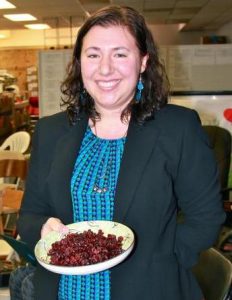 Rachel Sayet (Mohegan) received her BS from Cornell University in Restaurant Management in 2007 and her MA in anthropology from Harvard University in 2012. She has been working for the Mohegan Tribal Library since 2013, while also researching and promoting indigenous cuisine in New England. She has partnered with the Mohegan tribal health department on numerous events including gardening, cooking, and storytelling workshops for Mohegan youth. She is also a member of the Be Well Committee at Mohegan Sun, where her role is to educate casino employees about the health benefits of Native American food, and for which she has recorded a cooking show. More recently she has recorded a radio show about tribal foodways, and formed the Native Food Discussion Group for Mohegan tribal members to promote traditional knowledge about seasonal eating, harvesting, growing and fishing practices. You can contact Rachel at rbsayet@gmail.com or follow her food adventures on Facebook and Tumblr @Uni Will Never Be Bacon.
Rachel Sayet (Mohegan) received her BS from Cornell University in Restaurant Management in 2007 and her MA in anthropology from Harvard University in 2012. She has been working for the Mohegan Tribal Library since 2013, while also researching and promoting indigenous cuisine in New England. She has partnered with the Mohegan tribal health department on numerous events including gardening, cooking, and storytelling workshops for Mohegan youth. She is also a member of the Be Well Committee at Mohegan Sun, where her role is to educate casino employees about the health benefits of Native American food, and for which she has recorded a cooking show. More recently she has recorded a radio show about tribal foodways, and formed the Native Food Discussion Group for Mohegan tribal members to promote traditional knowledge about seasonal eating, harvesting, growing and fishing practices. You can contact Rachel at rbsayet@gmail.com or follow her food adventures on Facebook and Tumblr @Uni Will Never Be Bacon.
